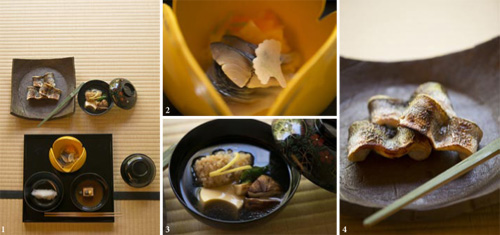Home > Highlighting JAPAN > Highlighting Japan NOVEMBER 2012 > Aesthetic Essentials
Highlighting JAPAN
COVER STORY: Japanese by Design
Aesthetic Essentials
The Japanese sense of beauty has come to be embodied in the design of various aspects of everyday life. We highlight traditional designs in clothing, dwellings and food, which are the basis of daily life. Takashi Sasaki and The Japan Journal's Osamu Sawaji report.
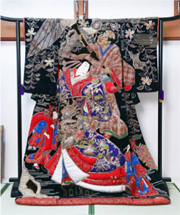
Uchikake, with oiran design, on display at the Japan Kimono Culture Museum. Created in the Meiji period (1868–1912). Uchikake is the outermost layer worn over another kimono.
Credit: YUICHI ITABASHI
Regarded as Japan's traditional dress, the main characteristic of the kimono is its simplicity of form. The front, back and sleeves of a kimono are all made by sewing a single piece of cloth measuring 12–13 meters long and about 38 cm wide, it is vastly different from Western clothes that cut the fabric to fit the shape of the wearer and are tailored in three dimensions. Because the silhouette is simple, color and pattern were important elements in creating a garment with aesthetic appeal, and the flat fabric acted as a canvas on which designs could be painted freely.
"The word 'kimono' is used to describe a whole range of garments, from everyday wear to wedding attire, all fundamentally consisting of a single piece of cloth that is wrapped around the entire body through the sleeves and is fastened with an obi (broad sash)," says Keiko Hagiya, director of Japan Kimono Culture Museum in Koriyama, Fukushima Prefecture. "In Japan, there was no custom of accentuating the body line with clothing. For this reason, the colors and pattern look beautiful whether viewed from the front or from the back."
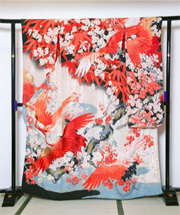
Furisode with plum tree and crane motif. Created in the Taisho period. Furisode is a formal style of kimono worn by young unmarried women, with longer than normal sleeves.
Credit: YUICHI ITABASHI
When the Edo period ended, new textile technology and chemical dyes from Europe and North America were introduced, and the designs of kimono became even more diverse. The many meisen (lustrous silk kimono of plain weave) from the Taisho (1912–1926) to early Showa (1926–1989) period in the Japan Kimono Culture Museum collection include kimono with Andersen fairy tale motifs and kimono with depictions of picturesque scenery in foreign lands.
Meanwhile, Japonisme had become fashionable in Europe following the Paris Expo in 1878, and had a significant impact on the fashion world. Particularly well-known is the fact that the founder of the French fashion brand Lanvin made a dress out of kimono fabric. This trend has continued to the present day, with world-renowned designers presenting new clothing and accessories made from rectangles cut from one bolt of cloth, inspired by the kimono. From 2010, kimono also appeared in the Tokyo Girls Collection, the fashion show known for its enthusiastic following of young Japanese girls. A fresh look at the appeal of the traditional kimono is stirring up excitement even among young Japanese.
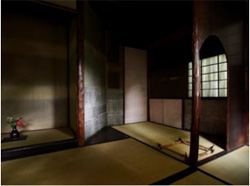
Inside the National Treasure Joan, located in the grounds of Meitetsu Inuyama Hotel in Inuyama, Aichi Prefecture. The tokonoma (alcove) pillar, cut out with a hack hammer, stands erect. Flowers are displayed in the tokonoma.
Credit: TADASHI AIZAWA
Tea was introduced into Japan around 1,200 years ago. Originally, it was a drink for the privileged classes, such as the nobility or priests, but eventually it became popular with the samurai and the general public, until by the fourteenth century sado (way of tea) had become established, a procedure of preparing tea according to a prescribed etiquette. The special architecture of the teahouse had played a key role in this world of the tea ceremony.
Around the end of the Warring States Period (late fifteenth century–late sixteenth century), major changes appeared in sado. These changes came about as a result of the creation of a new tea ceremony by the tea ceremony master Sen no Rikyu, who served under the holder of power at the time, Toyotomi Hideyoshi. This new tea ceremony was called "wabi-cha." "Wabi" is the idea of combining imperfection with opulence in order to accentuate the latter.
The design of the National Treasure chashitsu (tea house) Joan in the Meitetsu Inuyama Hotel in Inuyama, Aichi Prefecture is distinctly colored by this idea espoused by Rikyu. The manager of the Meitetsu Inuyama Hotel, Takami Fukuda, says, "The main feature of a tea house may be said to be that once you put yourself into that space, irrespective of your social standing or position of wealth, you can experience pure enjoyment from a bowl of tea."
Symbolic of this is the entrance for guests called the nijiriguchi. With a standard height and width of 65 centimeters, this is extremely small, so that no matter how high a person's social status, they could not enter without bending their knees and lowering their head.
When you enter the teahouse via the small Japanese garden called the roji, the first thing that strikes you is the soft light that floods the room. There are five windows in the teahouse, measuring just two and a half tatami mats (one mat is approximately 1.6 square meters), but all are obstructed by eaves, trees, or shoji screens. This means that direct sunlight does not filter in from any of the windows, creating a feeling of calm as if you had penetrated deep into the heart of a forest.
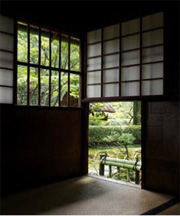
The entrance for guests, called the nijiriguchi, in Joan. The design means that visitors have to bend their knees and lower their head, irrespective of their social status.
Credit: TADASHI AIZAWA
"Compared with Rikyu's teahouses which, no matter how much they incorporate elements that evoke the simplicity and moral and physical fortitude of the samurai, such as the alcove pillar that is simply cut out with a hack hammer, still have an ascetic tension, this structure has an atmosphere that makes people feel at home and creates a tranquil state of mind," says Fukuda.
Today, only three National Treasure teahouses remain, including Joan. As modest as the structures are, if they are neglected they go back to nature in less than no time. However, the ideas of the creators that are infused in the tea houses are still deeply ingrained as one of Japan's traditional architectural styles seen in Japanese-style inns and restaurants, private homes, and other buildings.
Savoring the taste of the changing seasons: Kaiseki ryori
One of the traditional styles of Japanese cuisine, today kaiseki ryori has a firmly established image among Japanese people as an expensive, gourmet cuisine that is eaten at first-class Japanese restaurants. However, originally kaiseki ryori refers to dishes that were served to guests by the host at a tea ceremony before offering tea in accordance with sado.
"Kaiseki ryori consists of a simple meal comprising just a few basic dishes with no superfluous extras," says Yoshihiro Murata, proprietor of Kikunoi, a long-established ryotei (a particular type of high-class Japanese restaurant) in Kyoto.
"By serving just a few basic dishes, we enable our guests to experience the changing seasons, or by serving them foods harvested from the ocean or picked from the mountains, we enable them to imagine that they themselves went to the ocean or to the mountains. We the chefs select the ingredients and utensils and design the cuisine in order that our guests can enjoy this type of experience."
Kaiseki ryori is made up of ichi-ju san-sai (one soup and three side dishes). Ichi-ju san-sai is soup, rice, mukozuke (sashimi or a vinegar-based dish, for example), a simmered dish, and a grilled dish. In the tea ceremony, these foods are eaten in a prescribed order and manner.
During the course of its long history, the sizes of the food and utensils in kaiseki ryori have come to be established as those that the Japanese find easiest to eat or use. For example, the size of a rice bowl is four sun (approximately 12 centimeters) for men, and 3.8 sun (approximately 11.5 centimeters) for women. In Japan, rice is eaten from a rice bowl held in the hand, and these are the sizes that most Japanese people will feel comfortable holding. Likewise, sashimi is cut into slices of approximately 12 grams, since this is the size that will render the sashimi most flavorsome when placed in the mouth and chewed.
"Kaiseki ryori, including the cuisine and utensils, is something that brings together the sophistication of ergonomics, as it were," says Murata. "The design of kaiseki ryori with its aesthetic appeal and rationality has been shaped within the framework of the various rules of sado."
Kaiseki ryori is creative in its use of utensils and colors of ingredients in order to evoke a sense of the seasons. Aesthetic appeal is produced by creating colorful cuisine through the use of five colors (green, red, yellow, black, white). For example, in the fall this might mean using the yellow of yuzu fruit (citron) and chestnuts or the red of salmon roe. Or using pine needles or gingko leaves that have changed color as a garnish.
In addition to the cuisine and utensils, at Kikunoi the staff work wholeheartedly to ensure that the service and atmosphere of the restaurant evoke in the guests a sense of the changing seasons. For example, the flowers and vases, the hanging scrolls in the room, the clothing of the waitresses, and the cushions on which the guests sit, are all altered to suit the season.
"Kaiseki ryori is spatial art," says Murata. "There is meaning in every aspect of the design."
(1) Kaiseki ryori created by Yoshihiro Murata of Kikunoi for a fall tea party featuring, in the front, rice and soup, and (2) mukozuke of kakinamasu (persimmon tossed in vinegar) and mackerel in a yellow split sansho (a utensil in the shape of a split Japanese pepper berry evoking the fall); (3) a simmered dish of sea eel, egg tofu, matsutake mushrooms and yuzu fruit; and (4) grilled kamasu (barracuda) yuanyaki (meaning it was grilled with a liquid seasoning of soy sauce, sake, mirin cooking sake and yuzu).
Credit: MASATOSHI SAKAMOTO
© 2009 Cabinet Office, Government of Japan
